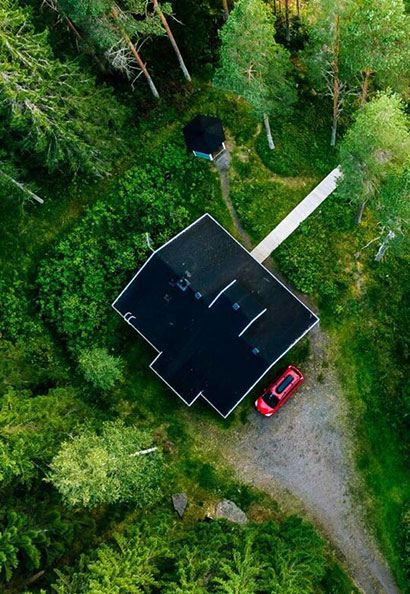A MUTED INTERIOR SHOWCASES DRAMATIC VIEWS OF NATURE
WRITTEN BY KATHRYN O’SHEA-EVANS
PHOTOGRAPHY BY MARK LOHMAN PHOTOGRAPHY
STYLING BY SUNDAY HENDRICKSON
You could call designer Alison Kandler the color queen. “We don’t do modern,” she says. Kandler is referring to the work she and her frequent design colleague—architect Joan Swartz—complete together as perfectly evidenced by Joan’s own 1930s cottage-style Santa Monica, California home, which Kandler recently revamped.
“She let me do my thing, but for her, more is better: more layers, more color, more flowers. You can tell by the house, she loves it all very colorful, and purple is her favorite,” says Kandler of the project. “She’s been married to her spouse for close to forty years, and she likes to say that he’s very comfortable with his masculinity—he’s not threatened by any of this.”
The home’s resulting look—where Granny Chic is taken to new highs—is a bit of a Kandler trademark. “I’m known for my color and my sense of whimsy.” In the kitchen, she installed an island painted a shade of eggplant with Benjamin Moore’s Passion Plum. “Everything sort of grew out of that.” Kandler calmed it down and warmed it up by opting for wood countertops. “They’re cherry—a lot less expensive than stone. As long as you keep water off them, they hold up great and they’re warm. Then we did white, laminated-glass cabinets, because in those upper cabinets I’m hiding a big column supporting the second floor.”
In the family room, Kandler culled colors from the rug and used them to paint the homeowner’s previously white breakfast table and chairs in mismatched hues, a la Monica Geller’s apartment in Friends. “I also took the table to black for a fresh look. I love reusing people’s existing pieces as much as possible; I’m not big on throwing things away!” Swartz tends to like every color except brown, so the designer toned down the color palette with white walls. She uses Dunn-Edwards’ Whisper in most houses, but this is Cottage White. “It’s got a nice, warm color to it; it’s a favorite, and gives that old cottage feel.”
If all this color seems a bit dizzying to organize, Kandler has a brilliant trick for keeping it cohesive. “Once I have a color palette in my head, I shop with that in mind,” she says. “I do these cards for each room using paint swatches.” Another tack? She sends her clients to the paint store and tells them to pick out colors that make them happy. “The only time it’s scary is when somebody only likes beige. It’s painful!” Selecting hues you naturally gravitate toward translates to interiors you won’t get sick of, says Kandler. “If you start with colors people love, they’re not likely to tire of them. I have not gotten any calls where somebody says, ‘I can’t handle the purple island anymore!’” Another tip: “I always send couples out separately to get paint swatches; it’s very interesting.”
MORE IS BETTER: MORE LAYERS, MORE COLOR, MORE FLOWERS.
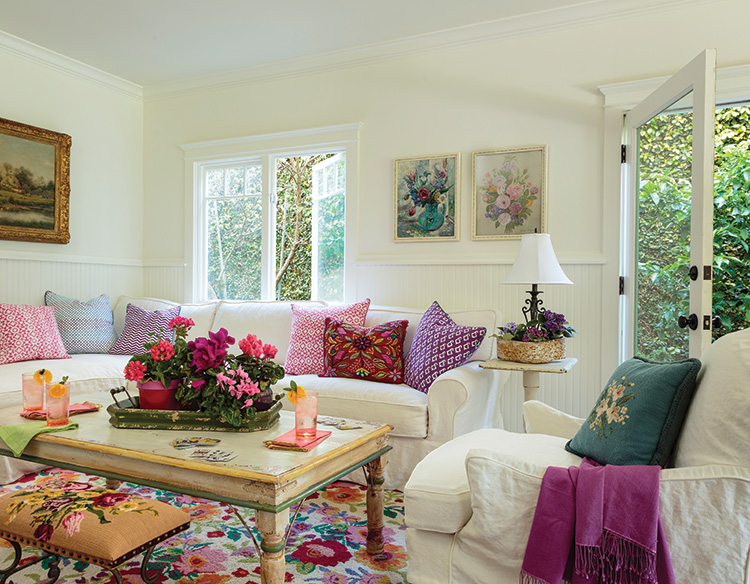
A One Kings Lane rug bursting with flowers pulls all the colors of the living room together, including throw pillows by Roller Rabbit. Barbie-pink touches lend a candy-sweet note to the bath. An old ladder provides a contrasting rustic perch for books.

A pink striped rug from Annie Selke’s Dash & Albert provides a cheerful foundation for a collection of vintage chairs.
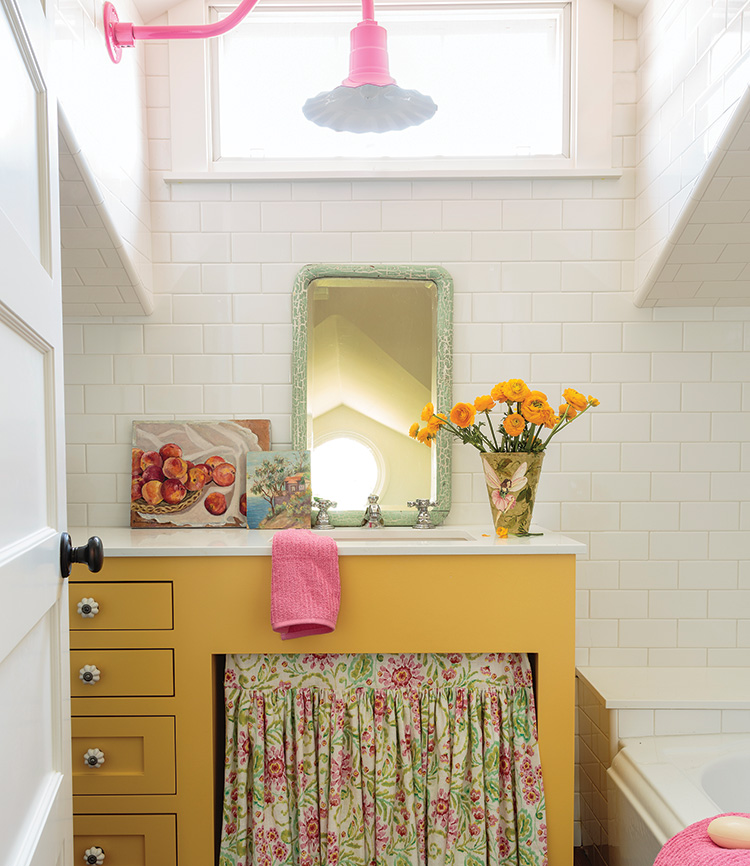
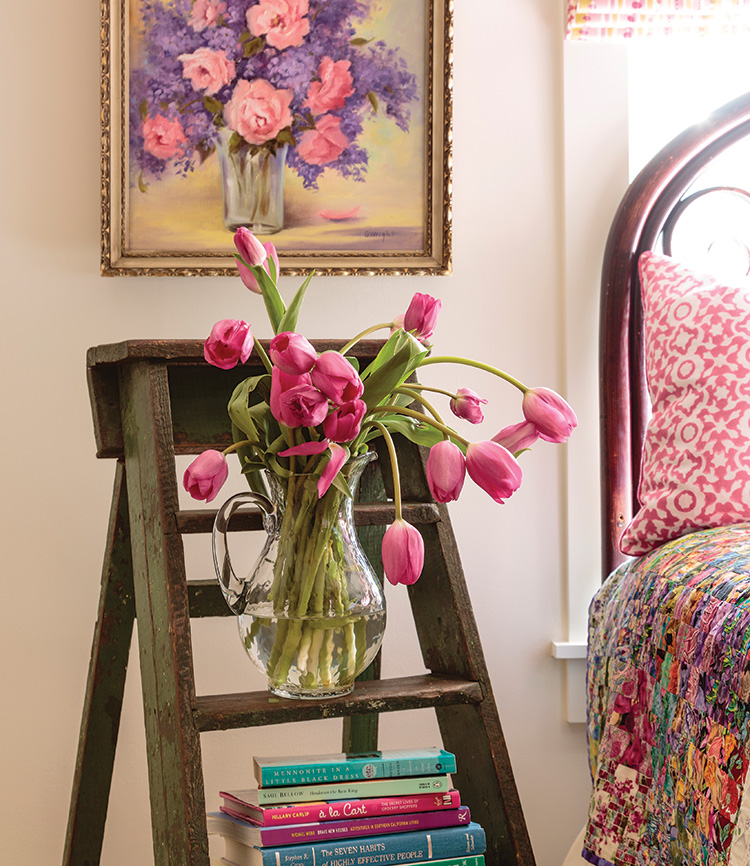
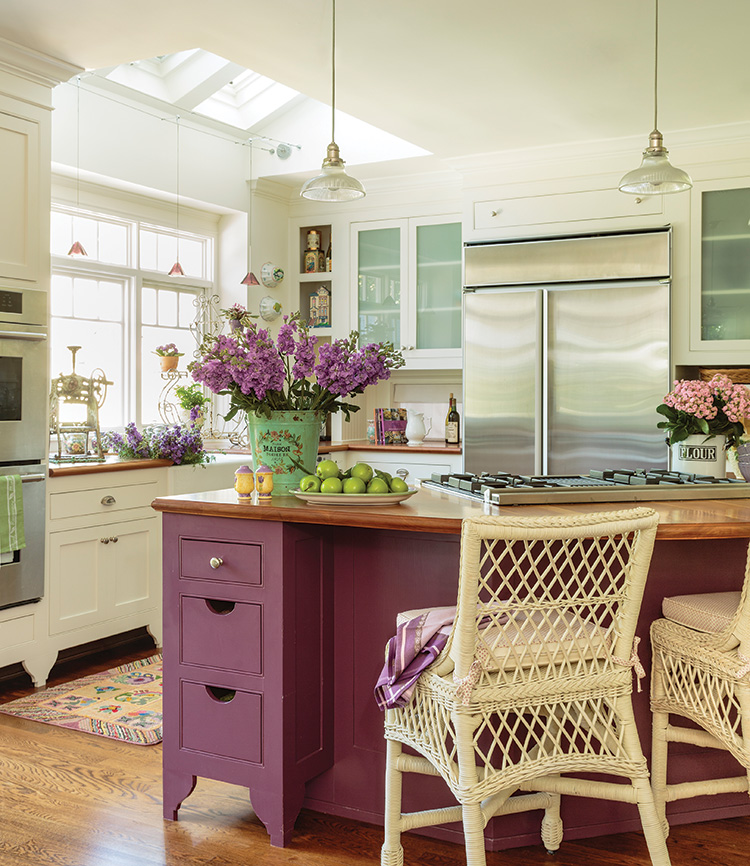
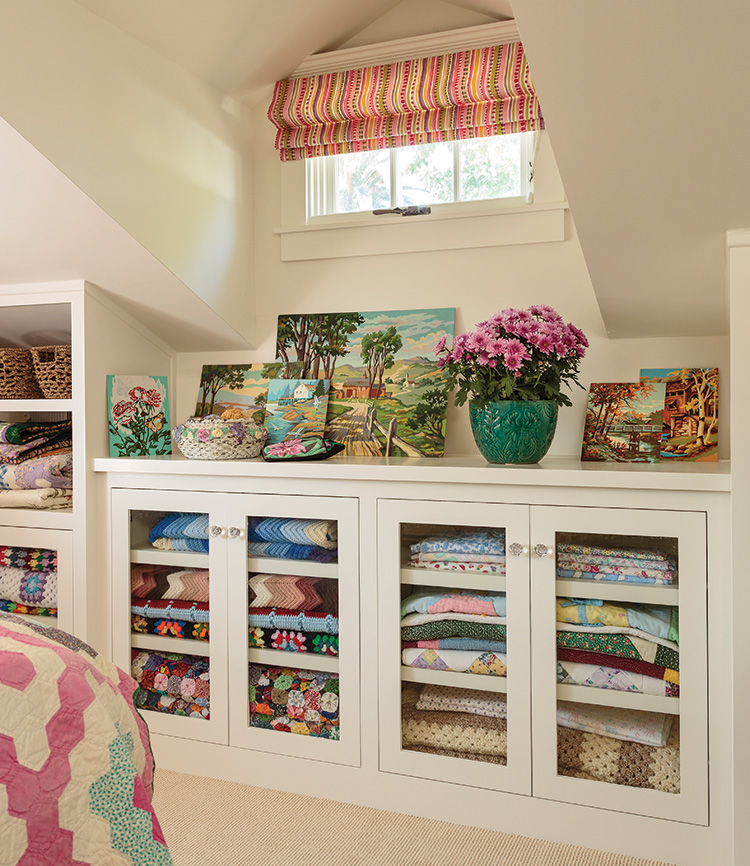
“The kitchen was tricky because there were no walls, really,” recalls Kandler of getting the home’s cottage style. Painting the island in Benjamin Moore’s Passion Plum grounds the area in plucky coziness. Quilts made by the client’s mother-in-law give throwback charm to a bedroom; tucking them behind glass-front cabinets keeps them looking organized and tricks the eye into seeing one thing in lieu of many.
One key to nailing the cottage look is to stock a home with hand-hewn, vintage finds that call to mind earlier eras. This particular project is chockablock with flea-market finds that Kandler and Swartz bought together. “She was not a flea-market person when I met her,” says Kandler. “I started showing her how to shop and she began collecting paintings; she probably has 400 amateur paintings up her stairs—you can barely see walls, [there are] so many paintings! More is more.”
A bit of a flea-market expert, Kandler has developed a horde of insider advice. Tip number one: don’t bring home projects. “The burnt chair you think you’re going to strip and recover—you’re not. It’s going to sit in the backyard and rot in the rain!” Instead, she tries to find things that are well-maintained, with original paint.
Fun upholstery and pillows are also key for the cottage look. In Swartz’s bedroom, the cabinets are filled with vintage quilts her mother-in-law made. “I love vintage fabrics. I’ll take tablecloths and turn them into seat cushions or curtains under sinks—especially if they have stains on them. And you can get them for $3 or less!” says Kandler. She also seeks out vintage pottery, especially if it’s flawed. “We live in earthquake country, so I always look for cracks and turn them to the back. If there’s an earthquake, I just don’t worry about it too much.”
The more imperfections the better for this designer. “I don’t like rooms to feel like they’re brand-spanking-new—I like it to feel like there’s depth to each room and somebody passed down a special piece. I don’t like it when you walk in a house and it feels like the decorator just bought everything.” And yes, Kandler lives in a cottage herself: an English beach cottage. “All the cottage trappings—scallops and corbels and full of light. Bring as much natural light as possible in. Cottages can get dark and gloomy, but light shows off all the colors!” Spoken like a true Color Queen.
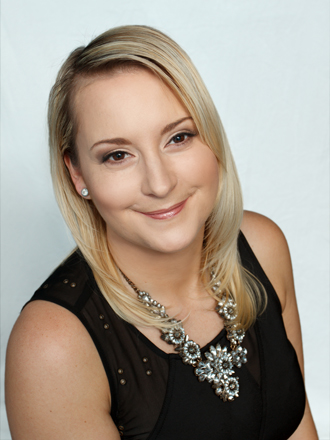
226.256.7999
amberjenings(at)peakpointrealestate(dotted)ca
peakpointre.realtor


